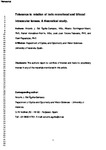Tolerance to rotation of toric monofocal and bifocal intraocular lenses. A theoretical study
| dc.contributor.author | Del Águila-Carrasco, AJ | |
| dc.contributor.author | Domínguez-Vicent, A | |
| dc.contributor.author | Monsálvez-Romín, D | |
| dc.contributor.author | Esteve-Taboada, JJ | |
| dc.contributor.author | Papadatou, E | |
| dc.date.accessioned | 2018-10-13T08:38:35Z | |
| dc.date.available | 2018-10-13T08:38:35Z | |
| dc.date.issued | 2018-03 | |
| dc.identifier.issn | 0030-4026 | |
| dc.identifier.issn | 1618-1336 | |
| dc.identifier.other | C | |
| dc.identifier.uri | http://hdl.handle.net/10026.1/12493 | |
| dc.description | publisher: Elsevier articletitle: Tolerance to rotation of toric monofocal and bifocal intraocular lenses. A theoretical study journaltitle: Optik articlelink: https://doi.org/10.1016/j.ijleo.2017.11.110 content_type: article copyright: © 2017 Elsevier GmbH. All rights reserved. | |
| dc.description.abstract |
This manuscript aims to evaluate the tolerance to rotation of a toric monofocal and a toric bifocal intraocular lenses with different cylinder powers. Theoretical designs based on wavefront aberrations were created to simulate a toric monofocal and a toric bifocal intraocular lens. Cylinder power ranged from −1 D to −6 D, in steps of −1 D. Tolerance to rotation was estimated by the visual Strehl ratio based on the optical transfer function (VSOTF) metric. Tolerance to rotation for both monofocal and bifocal intraocular lenses decreased when the cylinder power increased. For the bifocal design studied, the tolerance to rotation was larger for the near focus than for the far, however the overall quality was poorer for the near focus. Our findings show evidence that rotation tolerance depends both on the design of the intraocular lens and the cylinder power. This approach could be useful for predicting the tolerance to rotation of monofocal and multifocal toric intraocular lenses prior the surgery. | |
| dc.format.extent | 582-591 | |
| dc.language | en | |
| dc.language.iso | en | |
| dc.publisher | Elsevier | |
| dc.subject | Tolerance to rotation | |
| dc.subject | Toric intraocular lenses | |
| dc.subject | Bifocality | |
| dc.subject | Aberrations | |
| dc.subject | Visual optics | |
| dc.title | Tolerance to rotation of toric monofocal and bifocal intraocular lenses. A theoretical study | |
| dc.type | journal-article | |
| dc.type | Article | |
| plymouth.volume | 157 | |
| plymouth.publisher-url | http://dx.doi.org/10.1016/j.ijleo.2017.11.110 | |
| plymouth.publication-status | Published | |
| plymouth.journal | Optik | |
| dc.identifier.doi | 10.1016/j.ijleo.2017.11.110 | |
| plymouth.organisational-group | /Plymouth | |
| plymouth.organisational-group | /Plymouth/Faculty of Health | |
| plymouth.organisational-group | /Plymouth/REF 2021 Researchers by UoA | |
| plymouth.organisational-group | /Plymouth/REF 2021 Researchers by UoA/UoA03 Allied Health Professions, Dentistry, Nursing and Pharmacy | |
| plymouth.organisational-group | /Plymouth/Users by role | |
| plymouth.organisational-group | /Plymouth/Users by role/Academics | |
| dcterms.dateAccepted | 2017-11-19 | |
| dc.rights.embargodate | 2018-11-22 | |
| dc.identifier.eissn | 1618-1336 | |
| dc.rights.embargoperiod | Not known | |
| rioxxterms.versionofrecord | 10.1016/j.ijleo.2017.11.110 | |
| rioxxterms.licenseref.uri | http://www.rioxx.net/licenses/all-rights-reserved | |
| rioxxterms.licenseref.startdate | 2018-03 | |
| rioxxterms.type | Journal Article/Review |


